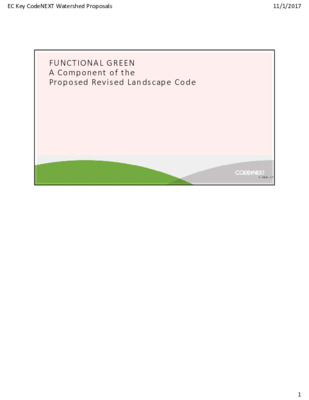Functional Green Presentation — original pdf
Backup

EC Key CodeNEXT Watershed Proposals 11/1/2017 FUNCTIONAL GREEN A Component of the Proposed Revised Landscape Code 1 - F E B - 1 7 1 Functional Green Landscape Code Integrates nature Provides flexibility Is straightforward Functional Green is a new tool in the City’s landscape code tool chest. It applies to sites with an IC allowance over 80% and is designed for getting nature into these dense urban sites. Functional Green integrates nature into parcels where building cover or other impervious surfaces limit what the standard landscape code can accomplish. It gives developers a planning tool that is flexible and provides ecological benefits comparable to those achieved by the standard landscape code. And it provides a program that is straightforward and clear to implement and review. 2 Ecosystem Services Microclimate Regulation Water Filtration Carbon Storage and Sequestration Biodiversity Benefits Human Well‐Being Air Pollutant Removal Stormwater Retention Effects on Developable Area Effects on Property Value Functional Green is based on the science of “ecosystem services,” the important benefits that people receive from healthy functioning ecosystems. A consultant team reviewed over 120 scientific, environmental studies, identifying ecological and economic benefits that could be expected from each Landscape Element in Austin’s geography and climate. We chose 8 Ecosystem Service benefits to base the Functional Green landscape code on: • • • • • • • • Microclimate Regulation Water Filtration Carbon Storage and Sequestration Biodiversity Benefits Human Well‐Being Air Pollutant Removal Stormwater Retention Effects on Developable Area Effects on Property Value 3 Ecosystem Services of Functional Green Landscape Elements The draft brochure from February of 2018, illustrates the relative benefits provided by each landscape element in a bar‐graph format. 4 EC Key CodeNEXT Watershed Proposals 11/1/2017 FUNCTIONAL GREEN How it Works The designer of a development chooses what landscape to provide by selecting from a menu of Functional Green landscape elements. 5 Menu of Landscape Options Vegetated (green) walls Porous paving Vegetated (green) roofs Irrigation with Auxiliary Water Source Rain Gardens Existing & new trees The landscape element menu includes, for example: • • • • • • Existing and new trees Vegetated (green) walls Vegetated (green) roofs Porous paving Rain gardens Irrigation with Auxiliary Water Source 6 Functional Green Score Area of Landscape Element A x Factor A + Area of Landscape Element B x Factor B + Area of Landscape Element C x Factor C Total Site Area = Score A proposed development must meet the specified Functional Green Target Score. This score represents the ecological function of a site relative to the total site area. Through research and testing, the consultant team and staff settled on a draft target score of 0.3. Each landscape element has a value, or “factor.” The factor values are based on the set of ecological and economic benefits presented above and are weighted relative to each other. To calculate a development’s Functional Green score, multiply the area of each landscape element by its factor; add these landscape‐element values together; and divide by the total site area. The answer is the proposed development’s Functional Green score. 7 Layer Landscape Elements You can maximize your score by layering landscape elements. For example, if you build a rain garden, you get the points for the area of the rain garden media. Add ornamental grasses, shrubs, and trees, and you get the points for the area of each of those additional landscape elements. 8 EC Key CodeNEXT Watershed Proposals 11/1/2017 FUNCTIONAL GREEN Case Studies Case Studies done by the consultant team provide examples of how Functional Green would be applied to some existing Austin sites. 9 South Congress Hotel Functional Green Score: 0.33 Use: Hotel Site Area: 0.95 acres Impervious Cover: 95% As constructed, this hotel achieves a score greater than the target score of 0.3 using South Congress Hotel • Planted trees, • Shrubs & ornamental plants, • Ground cover, and • Vegetated walls. 10 Austonian Functional Green Score: 0.31 Use: Mixed‐use Site Area: 0.65 acres Impervious Cover: 100% This residential high‐rise achieves a score greater than the target score of 0.3 with: • An extensive and intensive green roof, The Austonian • Planted trees, • Shrubs, • Ornamental grasses, • Ground cover, • A cistern, and • Auxiliary water irrigation of the landscape. 11 Galileo at 25 th Functional Green Score: 0.22 Use: Residential Size: 0.33 acres Impervious Cover: 90% This residential low‐rise achieves a score of 0.22 with Galileo at 25th • Planted trees, • Shrubs, and • Ground cover. + 1000 sq. ft. vegetated wall, + 2,710 gallon cistern, + Landscape irrigation with auxiliary water, and + Suspended pavement system. One way the project could reach the target score of 0.3 is with the addition of: 12 5 th & Colorado Functional Green Score: 0.13 Use: Office Site Area: 0.66 acres Impervious Cover: 100% 5th & Colorado This downtown office high‐rise achieves a score of 0.13 with: • Planted trees and • A suspended pavement system. The project could reach the target score of 0.3 with the additions of: + 5000 sq. ft. extensive green roof, + 6,177 gallon cistern, and + Landscape irrigation with auxiliary water. 13 EC Key CodeNEXT Watershed Proposals 11/1/2017 Landscape Code: Functional Green Questions & Comments Pamela Abee‐Taulli Environmental Review Specialist Senior 512.974.1879 pamela.abee‐taulli@austintexas.gov In the backup for this meeting, I provided the 2018 draft brochure and the 2019 proposed code and criteria language for Functional Green. You will see that revisions were made between those two documents. 14